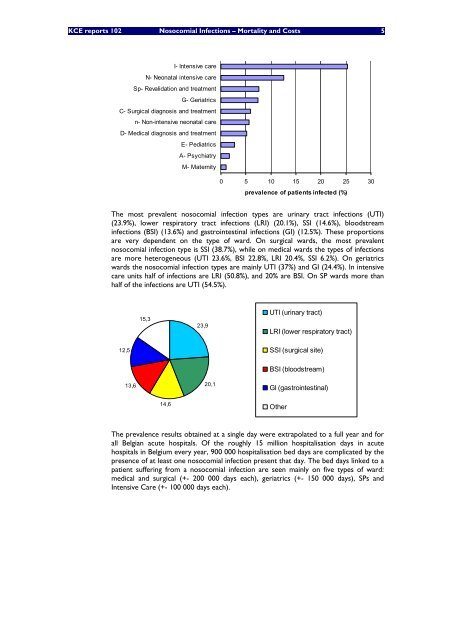Nosocomiale Infecties in België, deel II: Impact op Mortaliteit ... - KCE
Nosocomiale Infecties in België, deel II: Impact op Mortaliteit ... - KCE
Nosocomiale Infecties in België, deel II: Impact op Mortaliteit ... - KCE
Create successful ePaper yourself
Turn your PDF publications into a flip-book with our unique Google optimized e-Paper software.
<strong>KCE</strong> reports 102 Nosocomial Infections – Mortality and Costs 5<br />
I- Intensive care<br />
N- Neonatal <strong>in</strong>tensive care<br />
Sp- Revalidation and treatment<br />
G- Geriatrics<br />
C- Surgical diagnosis and treatment<br />
n- Non-<strong>in</strong>tensive neonatal care<br />
D- Medical diagnosis and treatment<br />
E- Pediatrics<br />
A- Psychiatry<br />
M- Maternity<br />
0 5 10 15 20 25 30<br />
prevalence of patients <strong>in</strong>fected (%)<br />
The most prevalent nosocomial <strong>in</strong>fection types are ur<strong>in</strong>ary tract <strong>in</strong>fections (UTI)<br />
(23.9%), lower respiratory tract <strong>in</strong>fections (LRI) (20.1%), SSI (14.6%), bloodstream<br />
<strong>in</strong>fections (BSI) (13.6%) and gastro<strong>in</strong>test<strong>in</strong>al <strong>in</strong>fections (GI) (12.5%). These pr<strong>op</strong>ortions<br />
are very dependent on the type of ward. On surgical wards, the most prevalent<br />
nosocomial <strong>in</strong>fection type is SSI (38.7%), while on medical wards the types of <strong>in</strong>fections<br />
are more heterogeneous (UTI 23.6%, BSI 22.8%, LRI 20.4%, SSI 6.2%). On geriatrics<br />
wards the nosocomial <strong>in</strong>fection types are ma<strong>in</strong>ly UTI (37%) and GI (24.4%). In <strong>in</strong>tensive<br />
care units half of <strong>in</strong>fections are LRI (50.8%), and 20% are BSI. On SP wards more than<br />
half of the <strong>in</strong>fections are UTI (54.5%).<br />
12,5<br />
13,6<br />
15,3<br />
14,6<br />
23,9<br />
20,1<br />
UTI (ur<strong>in</strong>ary tract)<br />
LRI (lower respiratory tract)<br />
SSI (surgical site)<br />
BSI (bloodstream)<br />
GI (gastro<strong>in</strong>test<strong>in</strong>al)<br />
Other<br />
The prevalence results obta<strong>in</strong>ed at a s<strong>in</strong>gle day were extrapolated to a full year and for<br />
all Belgian acute hospitals. Of the roughly 15 million hospitalisation days <strong>in</strong> acute<br />
hospitals <strong>in</strong> Belgium every year, 900 000 hospitalisation bed days are complicated by the<br />
presence of at least one nosocomial <strong>in</strong>fection present that day. The bed days l<strong>in</strong>ked to a<br />
patient suffer<strong>in</strong>g from a nosocomial <strong>in</strong>fection are seen ma<strong>in</strong>ly on five types of ward:<br />
medical and surgical (+- 200 000 days each), geriatrics (+- 150 000 days), SPs and<br />
Intensive Care (+- 100 000 days each).

















